what is selected when you point to and click a column heading
Lesson seven: Cell Nuts
/en/excel2013/saving-and-sharing-workbooks/content/
Introduction
Whenever you work with Excel, you'll enter data—or content—into cells. Cells are the basic building blocks of a worksheet. Yous'll demand to learn the basics of cells and cell content to calculate, clarify, and organize data in Excel.
Optional: Download our practice workbook.
Understanding cells
Every worksheet is made up of thousands of rectangles, which are chosen cells. A prison cell is the intersection of a row and a column. Columns are identified by letters (A, B, C), while rows are identified by numbers (one, 2, 3).
 A cell
A cell
Each cell has its own name—or jail cell address—based on its column and row. In this case, the selected cell intersects column C and row 5, and then the cell address is C5. The cell address will besides appear in the Name box. Note that a prison cell's column and row headings are highlighted when the cell is selected.
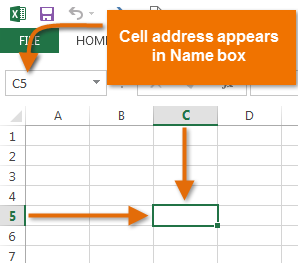 Prison cell C5
Prison cell C5
You tin also select multiple cells at the aforementioned time. A group of cells is known as a prison cell range. Rather than a single cell address, you will refer to a prison cell range using the jail cell addresses of the first and last cells in the cell range, separated by a colon. For instance, a prison cell range that included cells A1, A2, A3, A4, and A5 would be written every bit A1:A5.
In the images beneath, two dissimilar cell ranges are selected:
- Prison cell range A1:A8
 Cell range A1:A8
Cell range A1:A8
- Cell range A1:B8
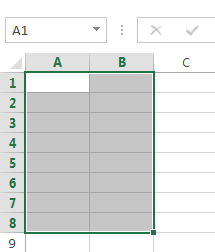 Cell range A1:B8
Cell range A1:B8
If the columns in your spreadsheet are labeled with numbers instead of letters, you'll need to modify the default reference style for Excel. Review our Actress on What are Reference Styles? to learn how.
To select a cell:
To input or edit cell content, y'all'll first demand to select the jail cell.
- Click a cell to select it.
- A border
 will appear around the selected cell, and the column heading and row heading will be highlighted. The cell volition remain selected until yous click another cell in the worksheet.
will appear around the selected cell, and the column heading and row heading will be highlighted. The cell volition remain selected until yous click another cell in the worksheet.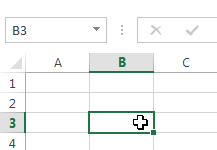 Selecting a single jail cell
Selecting a single jail cell
You can besides select cells using the arrow keys on your keyboard.
To select a prison cell range:
Sometimes you lot may want to select a larger group of cells, or a prison cell range.
- Click, hold, and drag the mouse until all of the adjoining cells you want to select are highlighted.
- Release the mouse to select the desired cell range. The cells will remain selected until you click some other cell in the worksheet.
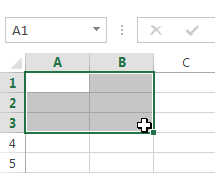 Selecting a cell range
Selecting a cell range
Cell content
Whatsoever information yous enter into a spreadsheet will be stored in a cell. Each cell can contain different types of content, including text, formatting, formulas, and functions.
- Text
Cells can incorporate text, such as letters, numbers, and dates.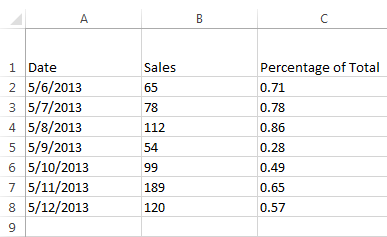 Cell text
Cell text - Formatting attributes
Cells can contain formatting attributes that alter the way letters, numbers, and dates are displayed. For example, percentages tin can appear as 0.fifteen or 15%. Y'all tin can fifty-fifty change a jail cell's background colour.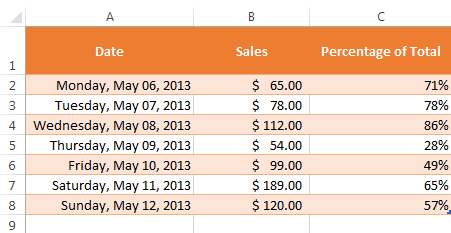 Prison cell formatting
Prison cell formatting - Formulas and functions
Cells tin incorporate formulas and functions that calculate cell values. In our instance, SUM(B2:B8) adds the value of each cell in cell range B2:B8 and displays the full in cell B9.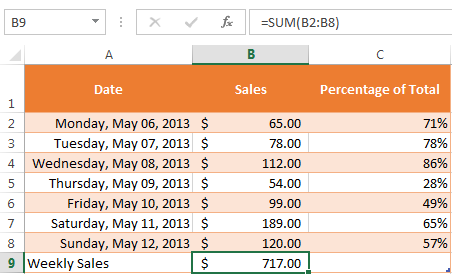 Prison cell formulas
Prison cell formulas
To insert content:
- Click a jail cell to select it.
 Selecting prison cell A1
Selecting prison cell A1 - Type content into the selected cell, then press Enter on your keyboard. The content will appear in the cell and the formula bar. You lot tin also input and edit cell content in the formula bar.
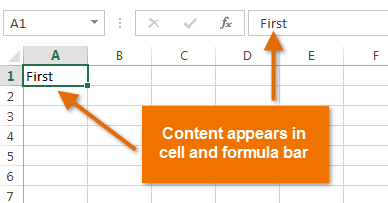 Inserting cell content
Inserting cell content
To delete cell content:
- Select the cell with content you want to delete.
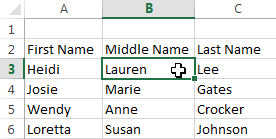 Selecting a cell
Selecting a cell
- Press the Delete or Backspace key on your keyboard. The cell's contents will be deleted.
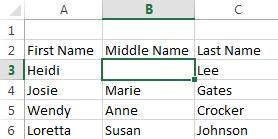 Deleting cell content
Deleting cell content
You can use the Delete key on your keyboard to delete content from multiple cells at once. The Backspace primal volition only delete one cell at a time.
To delete cells:
At that place is an of import difference between deleting the content of a cell and deleting the cell itself. If you delete the entire cell, the cells below it will shift up and replace the deleted cells.
- Select the cell(due south) you desire to delete.
 Selecting a cell to delete
Selecting a cell to delete - Select the Delete command from the Home tab on the Ribbon.
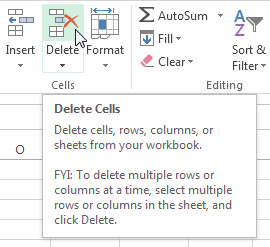 Clicking the Delete control
Clicking the Delete control - The cells beneath will shift upwardly.
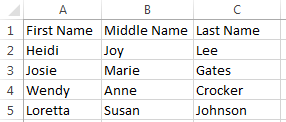 Cells shifted to replace the deleted prison cell
Cells shifted to replace the deleted prison cell
To copy and paste cell content:
Excel allows you lot to copy content that is already entered into your spreadsheet and paste that content to other cells, which tin save you time and effort.
- Select the cell(s) you want to copy.
 Selecting a prison cell to copy
Selecting a prison cell to copy - Click the Copy control on the Domicile tab, or press Ctrl+C on your keyboard.
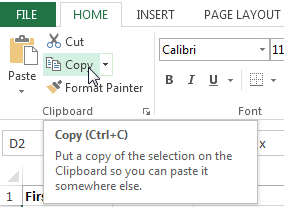 Clicking the Copy control
Clicking the Copy control - Select the cell(southward) where you want to paste the content. The copied cells will now have a dashed box around them.
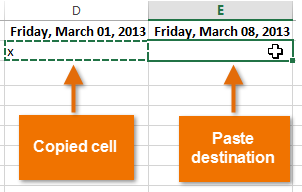 Pasting cells
Pasting cells - Click the Paste command on the Home tab, or press Ctrl+V on your keyboard.
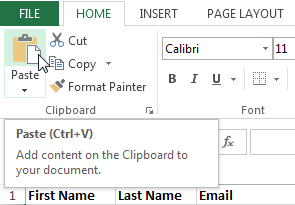 Clicking the Paste command
Clicking the Paste command - The content volition exist pasted into the selected cells.
 The pasted cell content
The pasted cell content
To cut and paste prison cell content:
Unlike copying and pasting, which duplicates jail cell content, cut allows y'all to move content between cells.
- Select the cell(due south) you lot desire to cut.
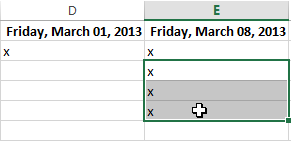 Selecting a cell range to cut
Selecting a cell range to cut - Click the Cut command on the Dwelling house tab, or press Ctrl+X on your keyboard.
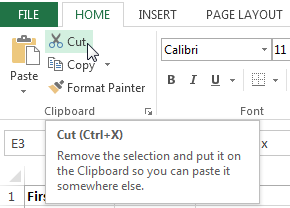 Clicking the Cut command
Clicking the Cut command - Select the cells where you desire to paste the content. The cut cells volition now accept a dashed box around them.
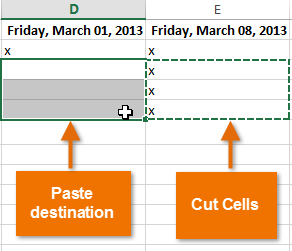 Pasting cells
Pasting cells
- Click the Paste control on the Home tab, or press Ctrl+V on your keyboard.
 Clicking the Paste command
Clicking the Paste command - The cut content will be removed from the original cells and pasted into the selected cells.
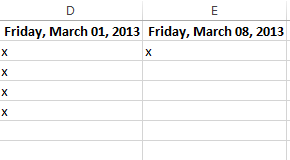 The cut and pasted cells
The cut and pasted cells
To access more than paste options:
Yous can also access additional paste options, which are especially convenient when working with cells that incorporate formulas or formatting.
- To access more than paste options, click the driblet-downward arrow on the Paste control.
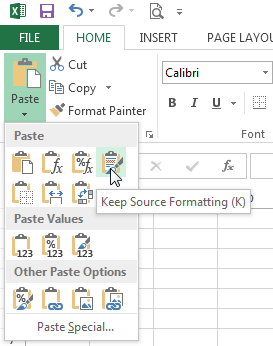 Additional Paste options
Additional Paste options
Rather than choose commands from the Ribbon, you lot can access commands quickly by right-clicking. Simply select the prison cell(s) y'all want to format, so correct-click the mouse. A drop-downward carte volition appear, where you'll find several commands that are besides located on the Ribbon.
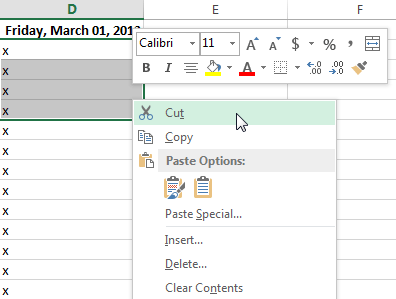 Right-clicking to access formatting options
Right-clicking to access formatting options
To drag and drop cells:
Rather than cut, copying, and pasting, y'all can drag and drop cells to move their contents.
- Select the cell(due south) you want to move.
- Hover the mouse over the border of the selected jail cell(south) until the cursor changes from a white cross
 to a blackness cantankerous with four arrows
to a blackness cantankerous with four arrows  .
.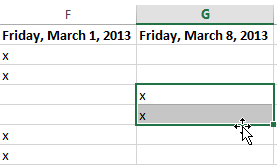 Hovering over the cell edge
Hovering over the cell edge
- Click, hold, and elevate the cells to the desired location.
 Dragging the selected cells
Dragging the selected cells - Release the mouse, and the cells will be dropped in the selected location.
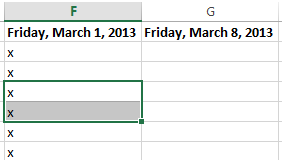 The dropped cells
The dropped cells
To use the fill handle:
There may exist times when you need to copy the content of one cell to several other cells in your worksheet. You lot could copy and paste the content into each prison cell, merely this method would exist time consuming. Instead, you can utilize the fill handle to quickly copy and paste content to side by side cells in the aforementioned row or cavalcade.
- Select the jail cell(s) containing the content you desire to utilize. The fill handle will announced every bit a pocket-sized foursquare in the bottom-right corner of the selected cell(s).
 Locating the fill handle
Locating the fill handle - Click, hold, and drag the fill handle until all of the cells you want to fill up are selected.
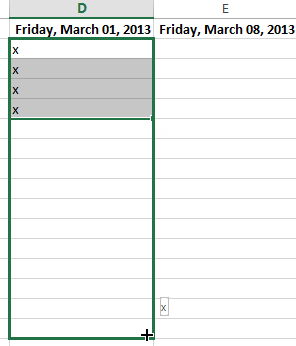 Dragging the make full handle
Dragging the make full handle - Release the mouse to fill the selected cells.
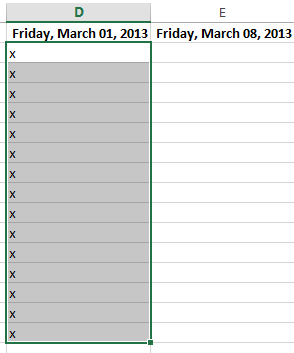 The filled cells
The filled cells
To go on a series with the fill handle:
The fill handle tin also be used to continue a serial. Whenever the content of a row or cavalcade follows a sequential order, similar numbers (1, ii, three) or days (Monday, Tuesday, Midweek), the fill handle tin can guess what should come next in the series. In many cases, yous may need to select multiple cells before using the fill handle to help Excel determine the series order. In our example below, the fill handle is used to extend a series of dates in a column.
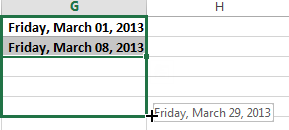 Using the fill handle to extend a series
Using the fill handle to extend a series
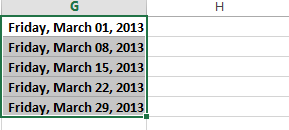 The extended serial
The extended serial
Yous can likewise double-click the fill handle instead of clicking and dragging. This tin exist useful with larger spreadsheets, where clicking and dragging may be awkward.
Watch the video below to see an example of double-clicking the fill handle.
To use Wink Fill:
A new feature in Excel 2013, Wink Fill tin enter data automatically into your worksheet, saving y'all time and attempt. Just similar the fill handle, Wink Make full can guess what type of data y'all're entering into your worksheet. In the example below, we'll utilise Flash Fill to create a list of first names using a list of existing email addresses.
- Enter the desired information into your worksheet. A Wink Fill preview will announced below the selected cell whenever Flash Fill is available.
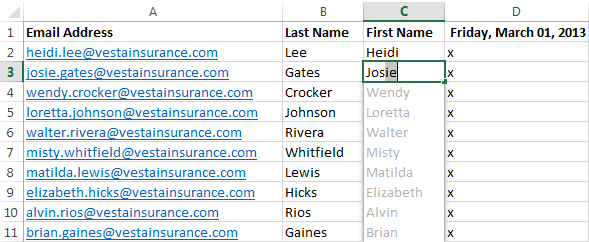 Previewing Flash Fill up data
Previewing Flash Fill up data - Press Enter. The Flash Fill up data volition exist added to the worksheet.
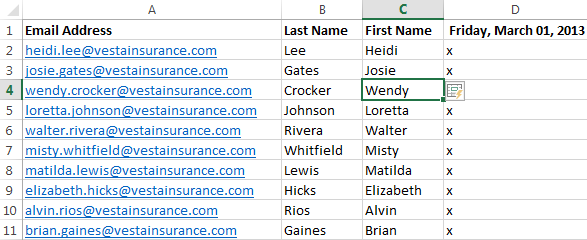 The entered Flash Fill information
The entered Flash Fill information
To modify or disengage Flash Fill, click the Wink Fill up button side by side to recently added Flash Make full data.
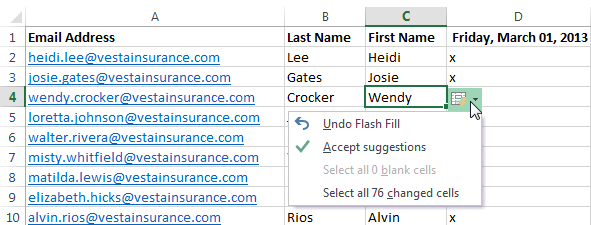 Clicking the Flash Fill button
Clicking the Flash Fill button
Detect and Replace
When working with a lot of information in Excel, it can be difficult and time consuming to locate specific information. You tin easily search your workbook using the Find feature, which also allows y'all to change content using the Replace characteristic.
To find content:
In our example, we'll use the Find control to locate a specific name in a long list of employees.
- From the Home tab, click the Find and Select command, and so select Find... from the driblet-downwards bill of fare.
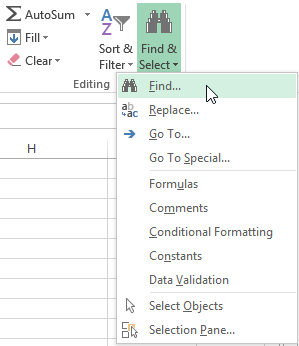 Clicking the Detect command
Clicking the Detect command - The Observe and Supersede dialog box will appear. Enter the content you lot want to find. In our instance, nosotros'll type the employee'due south name.
- Click Find Next. If the content is found, the cell containing that content volition be selected.
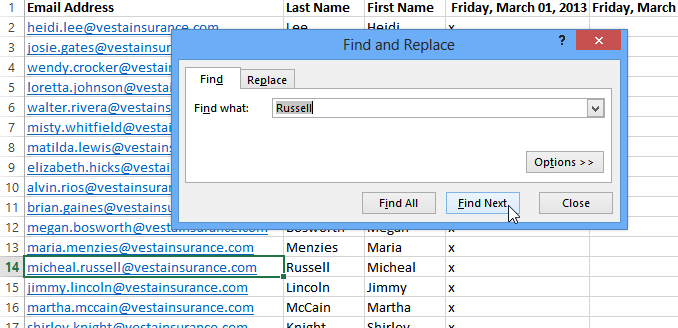 Clicking Discover Next
Clicking Discover Next - Click Find Next to find farther instances or Observe All to run into every instance of the search term.
 Clicking Notice All
Clicking Notice All - When you are finished, click Close to exit the Discover and Replace dialog box.
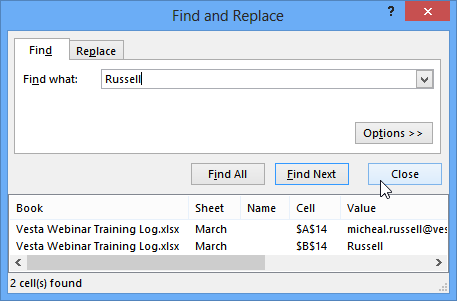 Closing the Find and Supervene upon dialog box
Closing the Find and Supervene upon dialog box
You lot tin as well access the Notice command by pressing Ctrl+F on your keyboard.
Click Options to see advanced search criteria in the Find and Supervene upon dialog box.
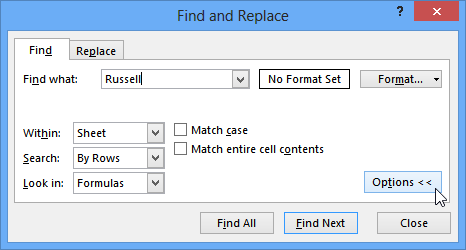 Clicking Options
Clicking Options
To supplant prison cell content:
At times, you may discover that you've repeatedly fabricated a error throughout your workbook (such every bit misspelling someone's name), or that you need to exchange a particular word or phrase for another. You can use Excel's Notice and Replace characteristic to make quick revisions. In our example, we'll employ Observe and Supersede to correct a list of email addresses.
- From the Home tab, click the Find and Select command, then select Supercede... from the drop-down carte.
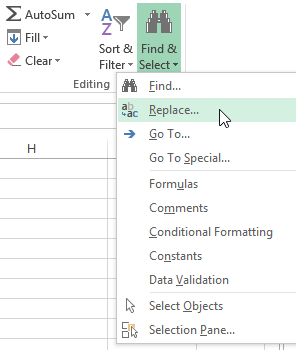 Clicking the Supersede command
Clicking the Supersede command - The Observe and Replace dialog box will appear. Type the text you want to find in the Find what: field.
- Type the text y'all desire to supercede it with in the Replace with: field, and then click Detect Next.
 Clicking Detect Side by side
Clicking Detect Side by side - If the content is found, the jail cell containing that content volition exist selected.
- Review the text to make sure yous want to replace it.
- If you desire to replace it, select one of the supervene upon options:
- Replace volition supervene upon individual instances.
- Replace All volition supervene upon every instance of the text throughout the workbook. In our example, we'll cull this choice to relieve time.
 Replacing the highlighted text
Replacing the highlighted text - A dialog box volition appear, confirming the number of replacements made. Click OK to proceed.
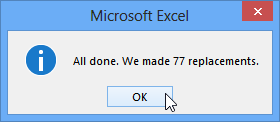 Clicking OK
Clicking OK - The selected cell content will be replaced.
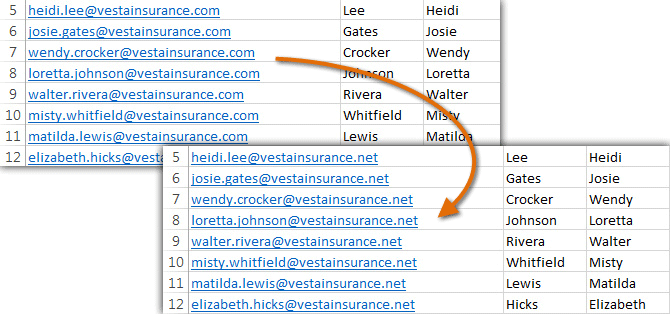 The replaced content
The replaced content - When you are finished, click Close to leave the Find and Replace dialog box.
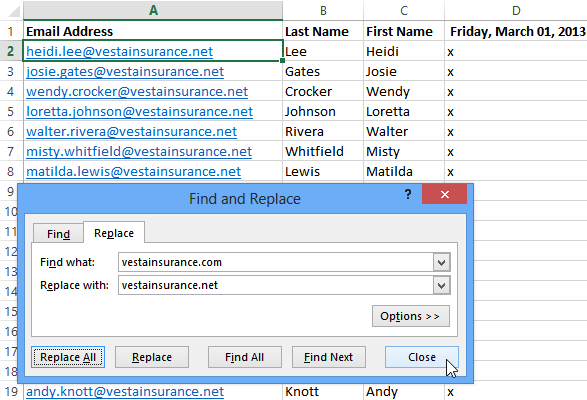 Closing the Find and Replace dialog box
Closing the Find and Replace dialog box
Challenge!
- Open up an existing Excel 2013 workbook. If yous want, you can utilize our practice workbook.
- Select cell D3. Find how the cell accost appears in the Proper noun box and its content appears in both the prison cell and the Formula bar.
- Select a jail cell, and attempt inserting text and numbers.
- Delete a cell, and annotation how the cells beneath shift upward to fill in its identify.
- Cut cells and paste them into a different location. If yous are using the example, cutting cells D4:D6 and paste them to E4:E6.
- Try dragging and dropping some cells to other parts of the worksheet.
- Use the fill handle to fill in data to bordering cells both vertically and horizontally. If you are using the instance, use the fill handle to continue the series of dates across row iii.
- Utilize the Find feature to locate content in your workbook. If you are using the example, type the name Lewis into the Notice what: field.
/en/excel2013/modifying-columns-rows-and-cells/content/
Source: https://edu.gcfglobal.org/en/excel2013/cell-basics/1/
0 Response to "what is selected when you point to and click a column heading"
Post a Comment